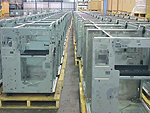Nov 10 2007
By recycling yet one more 5-pound toner cartridge from a Xerox multifunction system, Xerox Corporation (NYSE: XRX) announced today it has surpassed a major sustainability milestone by diverting more than 2 billion pounds of electronic waste from landfills around the world through waste-free initiatives that create sustainability benefits for the company and its customers.
Launched in 1991, long before sustainability was on most companies' radar screens Xerox's environmental program achieved the 2-billion-pound milestone by waste avoidance in two areas: reuse and recycling in imaging supplies and product take-back and recycling and parts reuse. In addition, Xerox integrates innovative environmental priorities into manufacturing operations to add to its recycling efforts.
 Equipment returned to Xerox can be remanufactured -- rebuilt -- to new performance specifications, reusing 70 to 90 percent by weight of machine components. Because of smart design, these sturdy frames can be used more than once, forming the skeleton for successive generations of printers and copiers.
Equipment returned to Xerox can be remanufactured -- rebuilt -- to new performance specifications, reusing 70 to 90 percent by weight of machine components. Because of smart design, these sturdy frames can be used more than once, forming the skeleton for successive generations of printers and copiers.
"Xerox's experience with reuse, recycling and remanufacturing has not only kept waste out of landfills, but saved the company more than $2 billion as it did so," said Patricia Calkins, Xerox vice president, Environment, Health and Safety. "If that amount of waste were loaded into garbage trucks, it would fill more than 160,000 trucks, stretching more than 1,000 miles, from Seattle to the Mexican border. We believe sustainability is an integral part of developing products, serving customers and posting profits."
Xerox Green World Alliance
Central to the company's commitment to waste-free products is the Xerox Green World Alliance, a reuse and recycling program for printer cartridges and toner. The program kept more than 2.7 million cartridges and toner containers and nearly 11 million pounds of waste out of landfills last year alone.
The Alliance is composed of two components - the remanufacturing of cartridges and the recovery and reuse of toner. When a cartridge is at the end of its life, customers send it to Xerox, which then cleans, inspects and remanufactures or recycles the cartridge. Remanufactured cartridges contain an average of 90 percent reused/recycled parts and are built and tested to the same performance specifications as new products.
Customers also send in waste toner, the dry ink that is used to make prints, to Xerox. Xerox then recovers and reuses the old toner by mixing it with new toner without compromising the product's functionality.
Equipment remanufacturing and reuse of parts
More than 15 years ago, Xerox pioneered the practice of converting end-of-life equipment into new products and parts. That approach has translated into significant environmental and financial benefits, preventing millions of pounds of waste from entering landfills - 111 million pounds in 2006 alone - while reducing the amount of raw material needed to manufacture new parts.
For these machines, Xerox equipment recovery/recycle operations disassemble parts that can be reused, adhering to stringent standards for quality and performance. The remaining components are disposed of or recycled. Of the 43,000 metric tons designated as equipment waste in 2006, Xerox reused or recycled 96 percent.
Environmentally-sensitive manufacturing processes
Recognizing that eliminating waste is not only good for the environment but also a smart manufacturing practice, Xerox's waste-free factory initiative has focused efforts on reducing the amount of non-hazardous waste generated by Xerox operations and on responsibly managing waste that cannot be eliminated. In 2006, Xerox recycled 91 percent of its non-hazardous waste, up from 80 percent in 2000.
The company is part of the U.S. Environmental Protection Agency's voluntary WasteWise program which targets the reduction of municipal solid waste and select industrial wastes. In addition, all its major manufacturing locations in the U.S. have earned membership in the EPA's National Environmental Performance Track. Only facilities with a record of sustained regulatory compliance and a history of environmental achievements are eligible to participate in the program.